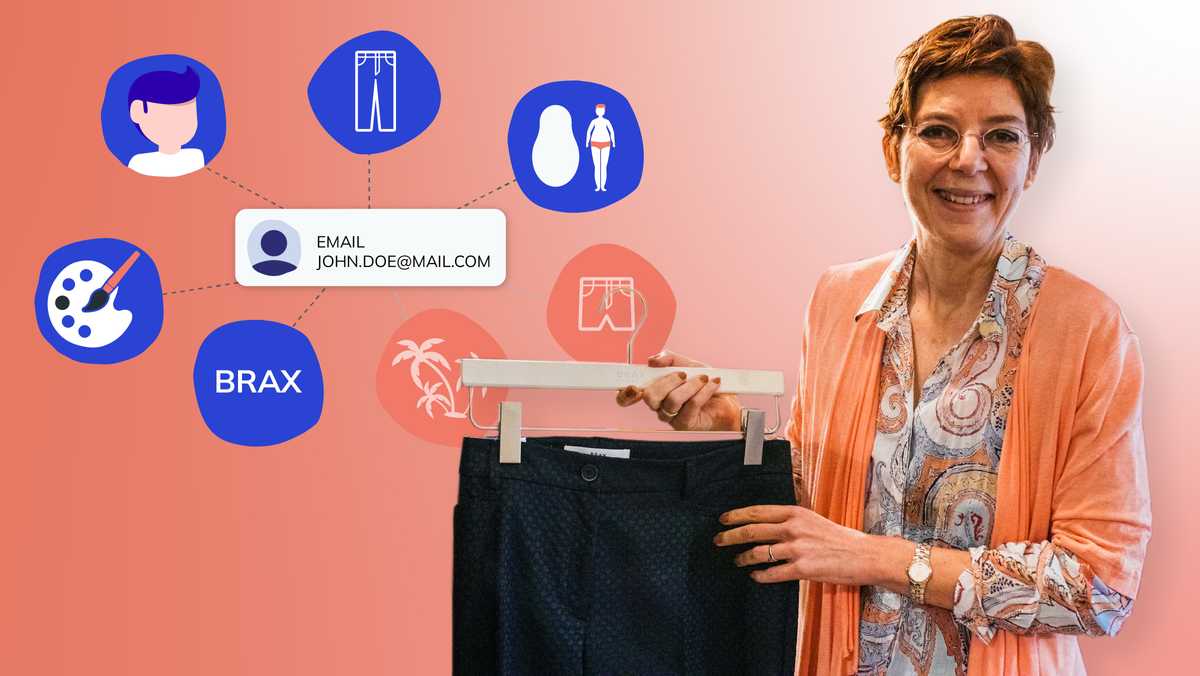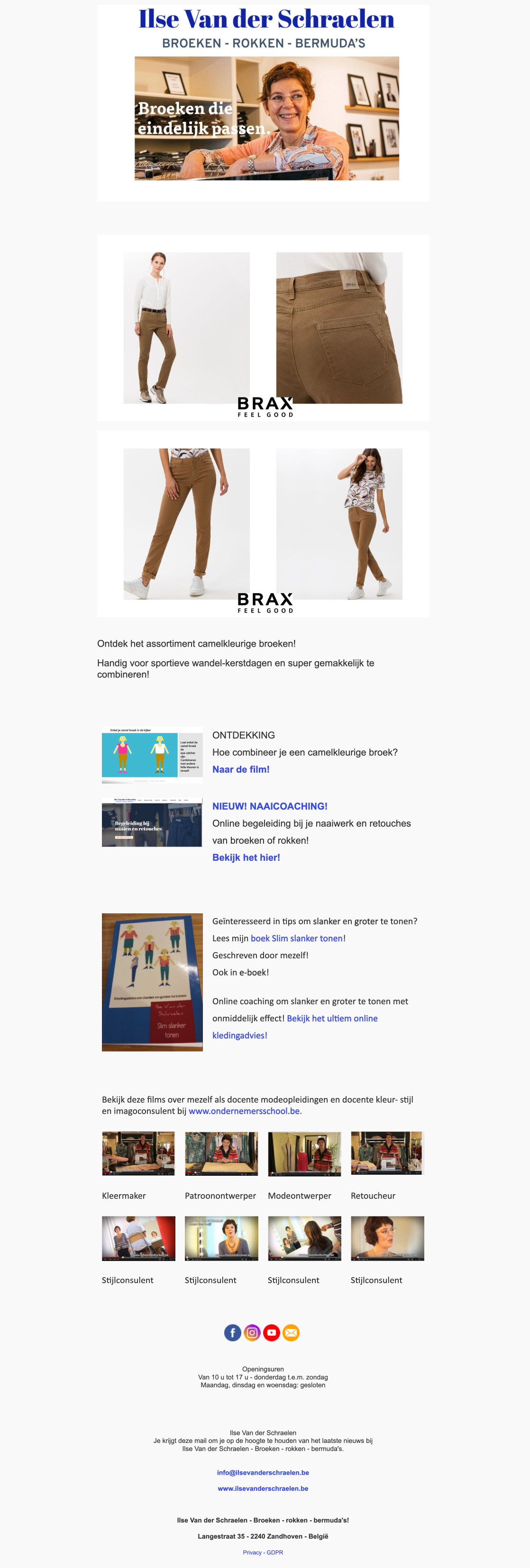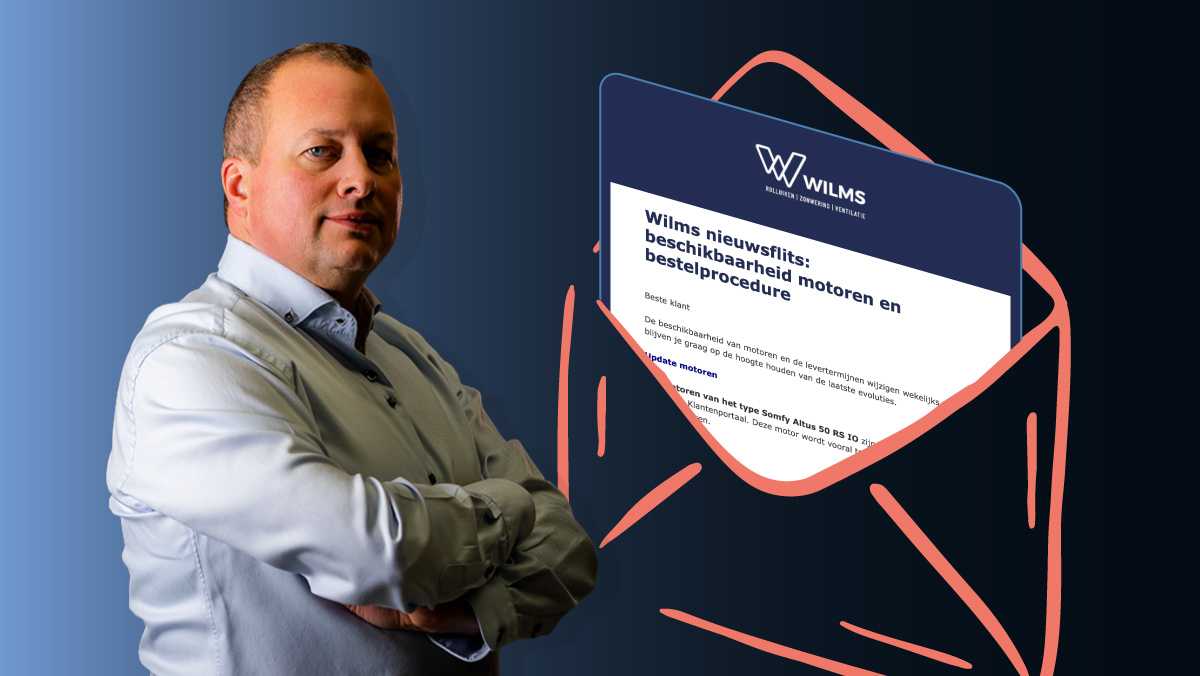Ilse Van der Schraelen, the ultimate trousers specialist, does her utmost to make her customers feel good, both offline and online. Yes, that’s right: she does not only sell bespoke trousers, but she also continues to help and advise her customers online, using email marketing in the process, with segmentation and automation playing a major role.
Educated as a commercial engineer, she has gathered many years’ additional insight into clothing (trousers in particular), sewing, tailoring, and email marketing of course. She has no intention of changing this. For Ilse, email marketing with Flexmail is a learning process in which she continues to grow and discover possibilities. Would you be interested?
Educated as a commercial engineer, she has gathered many years’ additional insight into clothing (trousers in particular), sewing, tailoring, and email marketing of course. She has no intention of changing this. For Ilse, email marketing with Flexmail is a learning process in which she continues to grow and discover possibilities. Would you be interested?
About Ilse Van der Schraelen

The ultimate trousers specialist with over 20 years’ experience and expertise
Ilse Van der Schraelen has run the fashion shop that has her name, in Zandhoven since 1999. In the course of time, she specialised in trousers as well as skirts and Bermuda shorts. Her mission? Find every customer a high-quality pair of trousers that really fits.Various target groups approached via Flexmail
To determine her target groups, Ilse looks at the subscriptions to her newsletter and at specific (physical) features she discerns with her own eyes, such as physique, colour type and gender. The customer’s favourite brand, colour or fabric of trousers are important too. This is where segmentation comes into play.Setting up a database a step at a time
You should take this quite literally.At a very early stage, as soon as I could in fact, I started collecting the first email addresses at a time when not everybody had one.Once it was technically possible, Ilse focused on email marketing. To be able to start, she first had to collect email addresses, of course. How did she go about it? Ilse explained she just asked her customers for their email addresses when they visited her shop and bought a pair of trousers. “The first customer had an email address, but the second and third customers did not,” Ilse says. “Initially, I was happy if I had received one or two email addresses on a single day.”
As time went by, more people had an email address, so Ilse’s list of email addresses grew longer quickly. It did not take long before she sent her first newsletter. “These were actual newsletters, created and sent with the help of a normal email program, the program we all use to send our daily emails.” Soon, she found out that this simple email software was not up to the task, although it was the obvious choice in those days.
As her database kept growing, segmentation became more important, especially with respect to trousers that really fit. “There are no two women with the same body shape: one woman has a larger belly; another has a very slim waist. These two need an entirely different pair of trousers,” Ilse adds. “The information you sent to one of them cannot be sent to the other and vice versa. Segmentation was the necessary next step.”
Using the right partner to reach the right people
In her first years, Ilse used free email marketing software. Its possibilities were limited, especially because her database kept growing and she wanted to continue to grow as well.“Eventually, the free software indicated: given the number of possibilities you currently use and the number of email addresses you have gathered, it is important that you make the transition to a paid package,” Ilse says.
So I have to pay now? This was a moment for me to stop and think. I realised this was going to be a very long partnership, so the partner had to be chosen with great care.We are very glad she chose us for a partner. By the way, Ilse calls herself Flexmail’s ‘Fan number 1’. As these are her words, we may proudly quote them here, don’t you agree?
Of course, we understand that the local aspect is one of our major benefits. Ilse regards cooperating with us as cooperating with a neighbour. But there is a lot more. She sent out Flexmail newsletters and then looked at the results. After a good customer contact had been established and a pair of trousers had actually been bought, she wanted to provide these specific customers with some extra service.
Flexmail offers the possibility of providing additional content and business afterwards. This is very interesting, if you ask me. Of course, people who bought a pair of trousers two weeks ago will get a different message than people who bought a pair two years ago.So it was time for Ilse to start with segmentation. She does not even present herself as a salesperson anymore. “I would rather consider myself someone who renders advice. I give advice and help customers on the basis of my expertise.” We have no doubt you want to know more about this.
Email marketing from a gut feeling and experience
For Ilse it is important to establish a bond with her readers and create trust. She does this by offering her customers content they really need, in both the period before and the period after the purchase. Ilse tries to reach everybody, regardless of how different they may be. “For the customers it is a relief they can say they found what they need, and I am very satisfied,” Ilse says.So what do her customers really need? Trousers and tailor-made advice! When a customer enters her shop, Ilse looks at this person’s body shape and colour type. After the visit, she (manually) enters this information in her Flexmail account. Next, it is all a matter of segmentation.
You really have to use your eyes and professional skills when you look at customers and know that this particular lady needs these particular trousers. Then you also know which types of messages you have to send to her in the future.More specifically:
There are ladies with large buttocks and ladies with very thin upper legs, men with and men without a belly, warm-colour or cool-colour types, etc. They all get different emails with specific professional knowledge and offers.
Ilse’s segmentation strategy goes a step further. There are also differences in purchasing. “People who bought black trousers need other information afterwards than people who bought a pair of Bermudas, for example. You could offer them maintenance tips, for instance, or tips on how best to wear their clothes. A black pair of trousers is worn in an entirely different way than a bright red paid.”
Do you want to get started with specific email communication, or do you want to have a good look at your existing segments? With this step-by-step guide we give you a leg-up. Our examples may inspire you.
Automation for every possible scenario
To make things easier for herself, Ilse opts for automation every time again. “It is an incredibly time-saving solution for me. It runs and keeps on running. I can go on holiday for a month, and still the trust with the customer continues to be built.”A customer who has bought a pair of trousers will end up in one of her automatic email flows. Next, this customer is offered content on the basis of the purchasing moment and the type, colour or brand of the trousers purchased. It looks like this:
You can imagine that Ilse has not set automatic scenarios for black and Brax trousers exclusively. Automation is also a matter of growth. “It started with one workflow, and I saw that it worked. Then I thought: if I can do this for a black pair of trousers, why not do it for a white or a red pair?” Ilse says. “You actually build it completely in one go. The next few times, you can make some changes very quickly, and off you go!”
Ilse likes the possibility of ending her email flows with a notification to herself. Whenever a mailing is sent, she receives a copy in her own inbox. Why does she do this?
It constantly keeps you alert and reminds you that improvements should be made whenever necessary. You create a certain message, and two weeks later it is sent. Then you read it again and see that perhaps you should have formulated or designed it differently. Then you can always make a quick adjustment.The customers’ opinions are also important. “If a customer says: ‘I received an email but this or that was unclear to me,’ I can always make some improvements,” Ilse says.
If it works, repeat it
If something works well, you should not change it. Take a look at the layout of Ilse’s mailings.I take the view that if certain layouts are effective, it is a good idea to repeat them. Customers recognise the type of email and know where they can find certain types of information. After some time, people know they can expect certain information from me.It is like Ilse says: “It is also nice for your readers that every time they receive an email, the layout is not an entirely new one which they have to get used to.”
So what do her emails look like exactly? At the top of this article, you have seen some of them. Ilse uses an example to give us a summary:
At the top of the newsletter, you can see what has come in new, what is the new fashion. Ilse provides a brief explanation underneath. In this example, the camel-coloured trousers are the new fashion. Scroll a bit further down to find the related content. ‘For whom is the camel colour suitable?’ ‘How to wear camel-coloured trousers?’ and ‘What can the colour of camel be combined with best?’ are possible content pieces provided by Ilse. “Customers who are only interested in the fashion part, will look at the top of the email. People reading the content, know they can find it at the bottom.”
Next up: keeping on growing
Ilse regards cooperating with us as an ongoing process. We do not need to explain this to you anymore. But what are her plans for the future? Segmenting, segmenting, segmenting. “I have a lot of other plans, like segmenting and offering more content, all at different moments. Working permanently with segments,” Ilse says.Using Flexmail only for sending newsletters wouldn’t do justice to its full potential. You have to use it more intensively by working with those segments. It’s like only using the first gear of your car. Not using all the other gears would be a shame. Only when you use all gears, you can enjoy the full benefit of your car.That is clear! Additionally, she wants to discover other possibilities and develop them further, such as link tracking. She wants to be able to send tailor-made emails to contacts who click certain links. Ilse also tells us that, on our recommendation, she is now sending surveys to her customers, by means of which they can indicate what they like or dislike about their purchase. “It is most helpful to read this information afterwards and learn from it.”
Ilse’s ultimate email marketing tip
Always speak about a customer with a specific characteristic.In other words, do not speak of ‘all my customers’. Every customer is different. They all have their individual characteristics and require a different approach. This brings us again to the importance of a segmented database that allows you to approach every target group differently.
What should you take into account? There is no such thing as one solution for a certain customer with specific characteristics. “No, there is a solution for that customer’s specific question. Customers want a personal answer to their question, and it can be provided,” Ilse says. “This is a different way of doing business altogether. Again, it is about helping people. You can give people advice instead of selling to them, and this is more fun for us and for the customers, of course.”
Finally, Ilse tells us what is important: never become a customer of an organisation; you need to cooperate with it. In her words, it sounds better: “If you feel you are not a customer but that you’re cooperating, you are dealing with a good organisation. It is the best thing that can happen to you,” according to Ilse. This applies to everybody, whether you send emails or receive them.










